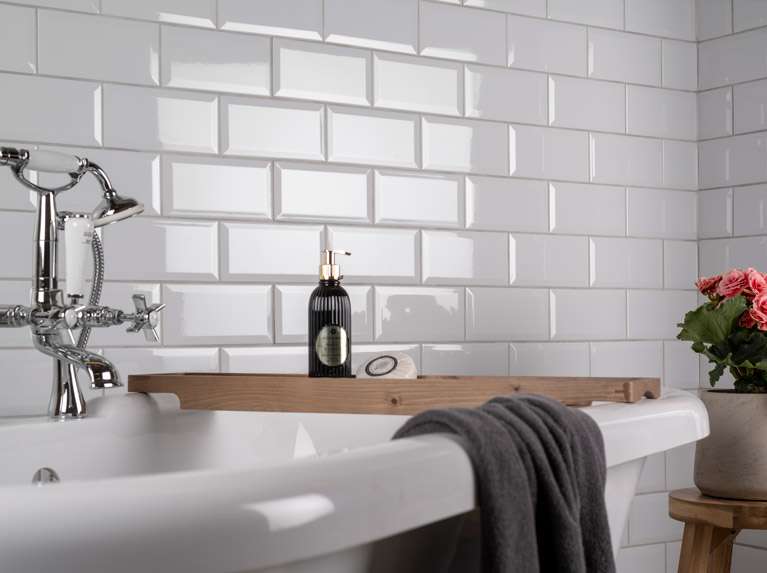Have you ever stared at a beautiful wall tile, dreaming of how it could transform your floors? It’s a common thought – wall tiles often boast stunning patterns and vibrant colors, making them tempting for a floor makeover. But before you dive into a DIY project, let’s explore the crucial factors to consider when deciding if wall tile is the right choice for your floor.

Image: elevate.in
This piece will delve into the world of wall versus floor tiles, unveiling the potential pitfalls and the opportunities that come with using wall tiles for your floors. We’ll dissect the differences, explore the pros and cons, and equip you with the knowledge to confidently make the best choice for your home.
The Tile Truth: Understanding the Differences
The world of tiles is a fascinating labyrinth of materials, finishes, and designs. But when it comes to flooring, the difference between wall and floor tiles boils down to more than aesthetics. It’s a matter of their structural integrity and intended use.
Wall tiles are designed for, well, walls! They’re lighter, thinner, and often made with more delicate materials, built for the less demanding environment of vertical surfaces. Their primary purpose is to add beauty and protection against splashes and dirt.
Floor tiles, on the other hand, are built for heavy traffic and wear. They’re typically thicker, denser, and comprised of materials that can withstand the constant pressure of foot traffic and furniture. They’re the warriors of the flooring world, standing strong against scratches, dents, and the inevitable spills of daily life.
Can Wall Tile Really Handle the Floor?
Now, let’s address the elephant in the room – can wall tiles actually work as flooring? The answer is: sometimes, but with significant caveats. It’s not a simple “yes” or “no.”
Think of it this way: Imagine using a delicate teacup to carry a heavy casserole. It might work for a few steps, but the risk of breakage is significant. Similarly, wall tile might handle light foot traffic in a low-use area, but it’s not built for the demands of high-traffic zones.
The Risks of Going Beyond Their Intended Use
Using wall tiles for flooring can lead to several drawbacks:
- Cracking and Breaking: Wall tiles are thinner and more brittle, making them prone to cracking under pressure from heavy foot traffic, furniture, or dropped objects. This can lead to the tile chipping, breaking, or becoming a safety hazard.
- Chipping and Scuffing: The glaze on wall tiles is often less durable than the finishes on floor tiles. This makes them more vulnerable to chipping, scratches, and scuffing, diminishing their aesthetic appeal over time.
- Slippage: Wall tiles are often glazed with a smooth finish that can be quite slippery when wet. This poses a potential safety hazard, especially in areas like kitchens and bathrooms where spills are common.
- Water Absorption: Some wall tiles are more porous than floor tiles, making them prone to moisture absorption. This can affect their durability, lead to mold growth, and potentially damage subfloors.

Image: www.wallsandfloors.co.uk
When Wall Tiles Can Be a Surprisingly Good Option
While we’ve highlighted the potential risks, there are situations where wall tiles might actually be a smart choice for your floor:
- Low Traffic Areas: Small spaces like bathrooms, mudrooms, or laundry rooms, where foot traffic is minimal, are more forgiving environments for wall tiles.
- Aesthetic Considerations: If you’re drawn to a particular wall tile design that’s not available in a floor tile version, you might decide the risks are worth the aesthetic payoff.
- Budget Constraints: Wall tiles are often more affordable than floor tiles, making them an appealing option for homeowners on a budget.
Expert Tips for Choosing the Right Tile: It’s All About the Details
Here’s where things get interesting. While some wall tiles are definitely a “no-go” for floors, others can work surprisingly well with a little careful consideration. Here’s what experts advise:
- Choose Thick and Durable Wall Tiles: Opt for wall tiles that are thicker than standard wall tiles and possess a denser composition, like porcelain.
- Look for Slip-Resistant Finishes: Ask for tiles with a higher slip coefficient, or look for textured finishes that provide better traction even when wet.
- Invest in Strong Grout: Invest in a high-quality, epoxy-based grout to fill the gaps between tiles and provide extra strength.
- Understand Your Subfloor: Ensure your subfloor is adequately level and strong to support the weight of the tiles.
- Talk to a Professional: Don’t hesitate to consult a flooring professional who can assess your specific needs and advise on the best tile options for your space.
Can I Use Wall Tile On Floor
Conclusion: The Power of Informed Decisions
While it might seem like a shortcut to use wall tile for your floor, the risks are worth considering. By understanding the differences between wall and floor tiles, evaluating the traffic patterns in your space, and carefully choosing durable options, you can make an informed decision that protects your investment and ensures a safe and beautiful floor for years to come.
So, go ahead, dream of those beautiful wall tiles, but arm yourself with knowledge before making the leap. And remember, choosing the right tile ultimately comes down to a thoughtful blend of aesthetics, durability, and safety.






